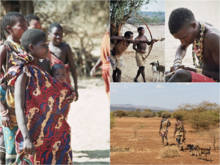Wahadzabe
Mandhari




Wahadzabe au Wahadza[1][2] ni kabila la Tanzania linaloishi hasa kandokando ya Ziwa Eyasi kwenye Bonde la Ufa na katika uwanda jirani wa Serengeti.
Leo Wahadza hawafikii 1,000:[3][4] kati yao 300–400 wanaishi bado kwa kuwinda na kuchuma vyakula bila uzalishaji, kama waliofanya mababu wao tangu awali.[5]
Wahadza hawana undugu wa karibu na kabila lingine lolote, na vilevile lugha yao ni ya pekee kabisa.[6][7][8]
Tanbihi
[hariri | hariri chanzo]- ↑ In the Hadza language, Hadzabe'e is the feminine plural form of Hadza. The Hadza call themselves the Hadzabe'e and their language Hadzane. Other spellings are Hadzapi ('they are Hadza men') and Hatsa; other ethnonyms applied to them include Tindiga (Watindiga), Kindiga, Kangeju, and Wahi. In current English usage, Hadza is the most commonly used term.
- ↑ Marlowe 2010, p. 15
- ↑ Marlowe 2010, p. 13
- ↑ Marlowe 2005 (see online)
- ↑ Marlowe 2010, pp. 17–18; 285–286
- ↑ Lee 1999, p. 200
- ↑ Sands, Bonny E. (1998) 'The Linguistic Relationship between Hadza and Khoisan' In Schladt, Matthias (ed.) Language, Identity, and Conceptualization among the Khoisan (Quellen zur Khoisan-Forschung Vol. 15), Köln: Rüdiger Köppe, 265–283.
- ↑ Ndagala & Zengu 1994
Marejeo
[hariri | hariri chanzo]- Apicella, C .L., & Feinberg, D. Voice pitch alters mate-choice relevant perception in hunter-gatherers. Proceedings of the Royal Society, B, 276, 1077-1082.
- Apicella, C. L., Little, A.C. & Marlowe, F.W. Averageness and attractiveness in an isolated population of hunter-gatherers. Perception, 36, 1813-1820.
- Blench, Roger (7–9 July 2008). "Hadza Animal Names" (PDF). 3rd International Khoisan Workshop. Riezlern.
- Crittenden, A.N. (2011). "The Importance of Honey Consumption in Human Evolution" (pdf). Food and Foodways. 19: 257–273. doi:10.1080/07409710.2011.630618.
- Crittenden, A.N. (2008). "Allomaternal Care among the Hadza of Tanzania" (pdf). Human Nature. 19. Marlowe, F.W.: 249–263. doi:10.1007/s12110-008-9043-3.
- Diamond, J. (1997). "Chapter 6". Guns, germs and steel: the fates of human societies. New York, NY: Norton. ISBN 0-393-03891-2.
{{cite book}}: Invalid|ref=harv(help) - Heller, Hartmut & Keulig, Steffen. (1999) (streamed video). Hadzabe – Die letzten Wildbeuter Ostafrikas. [Documentary]. Freunde der Naturvölker e.V. (fPcN Germany). http://vimeo.com/58452890. A film (43 min) in German about this people and their struggle for survival.
- Kohl-Larsen, Ludwig (1956a). Das Elefantenspiel. Mythen, Riesen und Stammessagen. Volkserzählungen der Tindiga. Das Gesicht der Völker (kwa German). Eisenach • Kassel: Erich Röth-Verlag.
{{cite book}}: CS1 maint: unrecognized language (link) The book is a collection of Hadza myths about giants, also some tribal myths about cultural heroes, and anecdotal tales. - Lee, Richard B. (1999). The Cambridge Encyclopedia of Hunters and Gatherers. Daly, Richard Heywood. Cambridge University Press. ISBN 0-521-57109-X.
{{cite book}}: CS1 maint: ref duplicates default (link) - Marlowe, F.W. (2005). "Mate preferences among Hadza hunter-gatherers" (pdf). Human Nature. 15: 364–375.
- Marlowe, F. W. (2010). The Hadza: Hunter-Gatherers of Tanzania. Berkeley: Univ. California Press. ISBN 978-0-520-25342-1.
{{cite book}}: Invalid|ref=harv(help) - Ndagala, D. K.; Zengu, N. (1994). "From the raw to the cooked: Hadzabe perceptions of their past". Katika Robert Layton (mhr.). Who needs the past?: indigenous values and archaeology. London: Routledge. ku. 51–56. ISBN 0-415-09558-1.
{{cite book}}: Invalid|ref=harv(help) - McCrummen, Stephanie. "50,000 Years of Resilience May Not Save Tribe", Washington Post, 2007-06-10, p. A01. Retrieved on 2007-09-15.
- Survival International. "Hadzabe celebrate land victory", 6 November 2007. Retrieved on 3 May 2011.
This citation will be automatically completed in the next few minutes. You can jump the queue or expand by hand
Marejeo mengine
[hariri | hariri chanzo]- Crittenden, Alyssa and Frank Marlowe (2008) Allomaternal Care among the Hadza of Tanzania. Human Nature: An Interdisciplinary Biosocial Perspective 19(3): 249-262.
- Finkel, M. (Desemba 2009). "The Hadza". National Geographic Magazine. Ilihifadhiwa kwenye nyaraka kutoka chanzo mnamo 2009-11-21. Iliwekwa mnamo 2014-09-14.
{{cite journal}}: Unknown parameter|dead-url=ignored (|url-status=suggested) (help)CS1 maint: date auto-translated (link) - Kohl-Larsen, Ludwig (1956). Das Zauberhorn. Märchen und Tiergeschichten der Tindiga (kwa German). Kassel: Erich Röth.
{{cite book}}: Unknown parameter|trans_title=ignored (|trans-title=suggested) (help)CS1 maint: unrecognized language (link) - Woodburn, James (1969). "An Introduction to Hadza Ecology". Katika Lee, Richard B.; DeVore, Irven; Wenner-Gren Foundation for Anthropological Research (whr.). Man the Hunter (tol. la 11th). Aldine Transaction. ku. 49–55. ISBN 0-202-33032-X.
{{cite book}}: External link in|chapterurl=|chapterurl=ignored (|chapter-url=suggested) (help) - Madsen, Andrew (2000). The Hadzabe of Tanzania: land and human rights for a hunter-gatherer community. Copenhagen: International Work Group for Indigenous Affairs (IWGIA). ISBN 87-90730-26-7.
- Matthiessen, Peter (1972) The Tree Where Man Was Born, Chapter X.
- Wood, Brian and Frank Marlowe (2011) Dynamics of postmarital among the Hadza: a kin investment model. Human Nature: An Interdisciplinary Biosocial Perspective. DOI 10.1007/s12110-011-9109-5
Viungo vya nje
[hariri | hariri chanzo]- Hadza bibliography Ilihifadhiwa 16 Mei 2008 kwenye Wayback Machine.
- Gli ultimi primitivi. Alla scoperta degli Hadzabe Documentary film (in Italian).
- Hadzabe. Retour vers l'âge de pierre. Les derniers chasseurs à l'arc de Tanzanie Documentary film (in French).
- The Hadza Bushmen of Tanzania
- Map of Hadzaland
| Makala hii kuhusu utamaduni wa Tanzania bado ni mbegu. Je, unajua kitu kuhusu Wahadzabe kama historia yake au mahusiano yake na mada nyingine? Labda unaona habari katika Wikipedia ya Kiingereza au lugha nyingine zinazofaa kutafsiriwa? Basi unaweza kuisaidia Wikipedia kwa kuihariri na kuongeza habari. |

